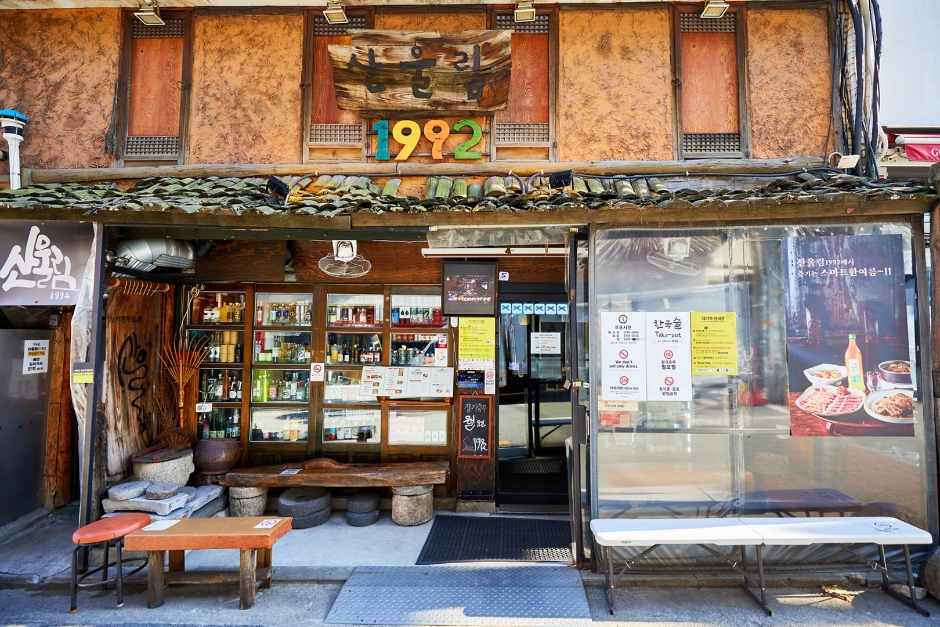BVLGARI - Hyundai Apgujeong Main Branch [Tax Refund Shop] (불가리 현대 본점)
5.9Km 2024-04-22
165, Apgujeong-ro, Gangnam-gu, Seoul
-
Fendi - Hyundai Apgujeong Main Branch [Tax Refund Shop] (펜디 현대 본점)
5.9Km 2024-04-23
165, Apgujeong-ro, Gangnam-gu, Seoul
-
Gentle Monster - Hyundai Apgujeong Main Branch [Tax Refund Shop] (젠틀몬스터 현대본점)
5.9Km 2024-04-16
1F, 165, Apgujeong-ro, Gangnam-gu, Seoul
-
Yongsan Family Park (용산가족공원)
5.9Km 2022-12-15
185, Seobinggo-ro, Yongsan-gu, Seoul
+82-2-792-5660
Visitors to Yongsan Family Park can enjoy a relaxing time at a big grassy field beside a refreshing pond and well-organized walking paths. Yongsan Family Park spans an area of roughly 89,256.20 ㎡ in what was a section of the former golf course of the Eighth US Army Division. The park is comprised of various facilities such as a 2km-walking path, a natural education site, and Taegeukgi Park. Visitors can watch and feed pigeons and wild pheasants living at the park.
Sanullim 1992 (산울림1992)
5.9Km 2024-03-15
60 Seogang-ro 9-gil, Mapo-gu, Seoul
This Korean bar and restaurant serves Korean dishes with nearly 200 types of traditional Korean liquor on offer, including makgeolli (unrefined rice wine), refined rice wine, and distilled liquor. Its food menu includes bean curd with stir-fried kimchi, ox knee soup (soup made by boiling down calcium-rich ox knee), and cabbage wraps with soy sauce braised pork. The signature menu here, however, is “Bansang,” set menus of the customer's choice ranging from No. 1 to No. 5 served on a round dining table. Each number has a different pricing and composition, but all offer new and unique flavors. The savory and crispy cheese and potato pancake goes perfectly with tangy omija makgeolli.
Olive Young - Changcheon Branch [Tax Refund Shop] (올리브영 창천)
5.9Km 2024-04-18
17, Sinchon-ro, Seodaemun-gu, Seoul
-
Seoul Upcycling Plaza (서울새활용플라자)
6.0Km 2024-01-05
49 Jadongchasijang-gil, Seongdong-gu, Seoul
Saehwaryong is a Korean term for upcycling, a process of redesigning or recycling discarded resources or materials to give them a new value or purpose. Seoul Upcycling Plaza operates upcycling-related exhibitions, upcycling practice education and experience programs, design studios, upcycling stores, workshops, and more. It is a great place to look around for ideas and inspirations on how to use products for longer periods of time. The plaza demonstrates the first step to creating a resource-recycling society.
KstarROAD 한류스타거리 (KstarROAD Hallyu Star Road)
6.0Km 2024-03-05
394, Apgujeong-dong, Gangnam-gu, Seoul
The K-Star ROAD is a place to meet the stories of celebrities who were at the forefront of the K-Wave phenomenon. The road features art toy statues inspired by K-Pop bands, such as SNSD, EXO, and TVXQ, while terminals next to shops help you find the fashion shops and restaurants frequented by celebrities. Moreover, the schools attended by the celebrities, houses in which they used to live, and other spots that capture their stories can also be found on this street.
Saebom Eyewear - Hongdae Branch [Tax Refund Shop] (새봄안경원 홍대)
6.0Km 2024-04-18
1F, 150-1, Wausan-ro, Mapo-gu, Seoul
-
Unplugged Hongdae Branch(언플러그드)
6.0Km 2025-11-05
26 Wausan-ro 33-gil, Mapo-gu, Seou
IU ‘Sleepless Rainy Night’
As the name suggests,it is a cafe with an analog charm. Old wooden floors and furniture, pianos and guitars, and turntables are old and more stylish. In a space full of LPs and CDs, you can feel the warmth and coziness you felt in the music video. A variety of menus are available, from drinks to beer and pretty cocktails named after musicians. There is a performance hall in the basement, where performances are often held.
![BVLGARI - Hyundai Apgujeong Main Branch [Tax Refund Shop] (불가리 현대 본점)](http://tong.visitkorea.or.kr/cms/resource/10/2890510_image2_1.jpg)
![Fendi - Hyundai Apgujeong Main Branch [Tax Refund Shop] (펜디 현대 본점)](http://tong.visitkorea.or.kr/cms/resource/38/2890538_image2_1.jpg)
![Gentle Monster - Hyundai Apgujeong Main Branch [Tax Refund Shop] (젠틀몬스터 현대본점)](http://tong.visitkorea.or.kr/cms/resource/99/2887999_image2_1.jpg)


![Olive Young - Changcheon Branch [Tax Refund Shop] (올리브영 창천)](http://tong.visitkorea.or.kr/cms/resource/64/2889364_image2_1.jpg)
![Saebom Eyewear - Hongdae Branch [Tax Refund Shop] (새봄안경원 홍대)](http://tong.visitkorea.or.kr/cms/resource/57/2878357_image2_1.jpg)
 English
English
 한국어
한국어 日本語
日本語 中文(简体)
中文(简体) Deutsch
Deutsch Français
Français Español
Español Русский
Русский